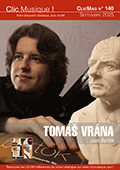 Deuxième volume de la série dédiée par Raphael Wallfisch aux concertos pour violoncelle écrits par des compositeurs juifs en exil, après la révélation de celui de Castelnuovo-Tedesco, couplé avec celui de Hans Gal. Cette fois, l’essentiel du CD est consacré au vaste concerto de Franz Reizenstein, qui fut d’abord l’élève de Hindemith avant de devenir celui de Vaughan Williams. Sa partition créée en 1951 frappe par son ampleur orchestrale et son caractère héroïque et sanguin digne de ses deux maîtres successifs. Bien qu’à peine plus tardif car créé en 1954, le concerto de Goldschmidt qui fut lui l’élève de Schreker à Berlin, procède d’une tout autre esthétique : quatre mouvements brefs aux titres renvoyant au néo-classicisme (Andante, Caprice mélancolique, Quasi Sarabande et Tarantelle), une écriture plus piquante, moins néo-romantique à l’évidence. Curieusement, Goldschmidt, interprète de Mahler salué par Hans Gal, est très loin des orchestrations complexes et du symbolisme de son premier professeur. Deux découvertes majeures à nouveau, magnifiées par l’archet de Raphael Wallfisch superbement accompagné par l’orchestre berlinois et Nicholas Milton. On attend la suite avec gourmandise et curiosité… (Richard Wander)  In Berlin the composers Berthold Goldschmidt and Franz Reizenstein developed into products of the anti-romantic »new realism.« However, both distanced themselves from this dry objectivity and sought more powerful means of expression while avoiding the late romantic excesses that at the time continued to predominate in Germany. The surprising fact is that neither Reizenstein nor Goldschmidt felt drawn to Schönberg’s method of twelve-tone composition. Already in 1934 and 1935 both composers fled from Berlin to England, that is, prior to the tightening of immigration requirements. Influences from Reizenstein’s teachers Paul Hindemith and Ralph Vaughan Williams are audible in the rather harsh, expressionistic character of his concerto. Raphael Wallfisch writes of this work, "Reizenstein’s Cello Concerto is a tour de force for the cellist. What is involved here is an epic and heroic statement in which lyrical and dramatic elements alternate".
|
